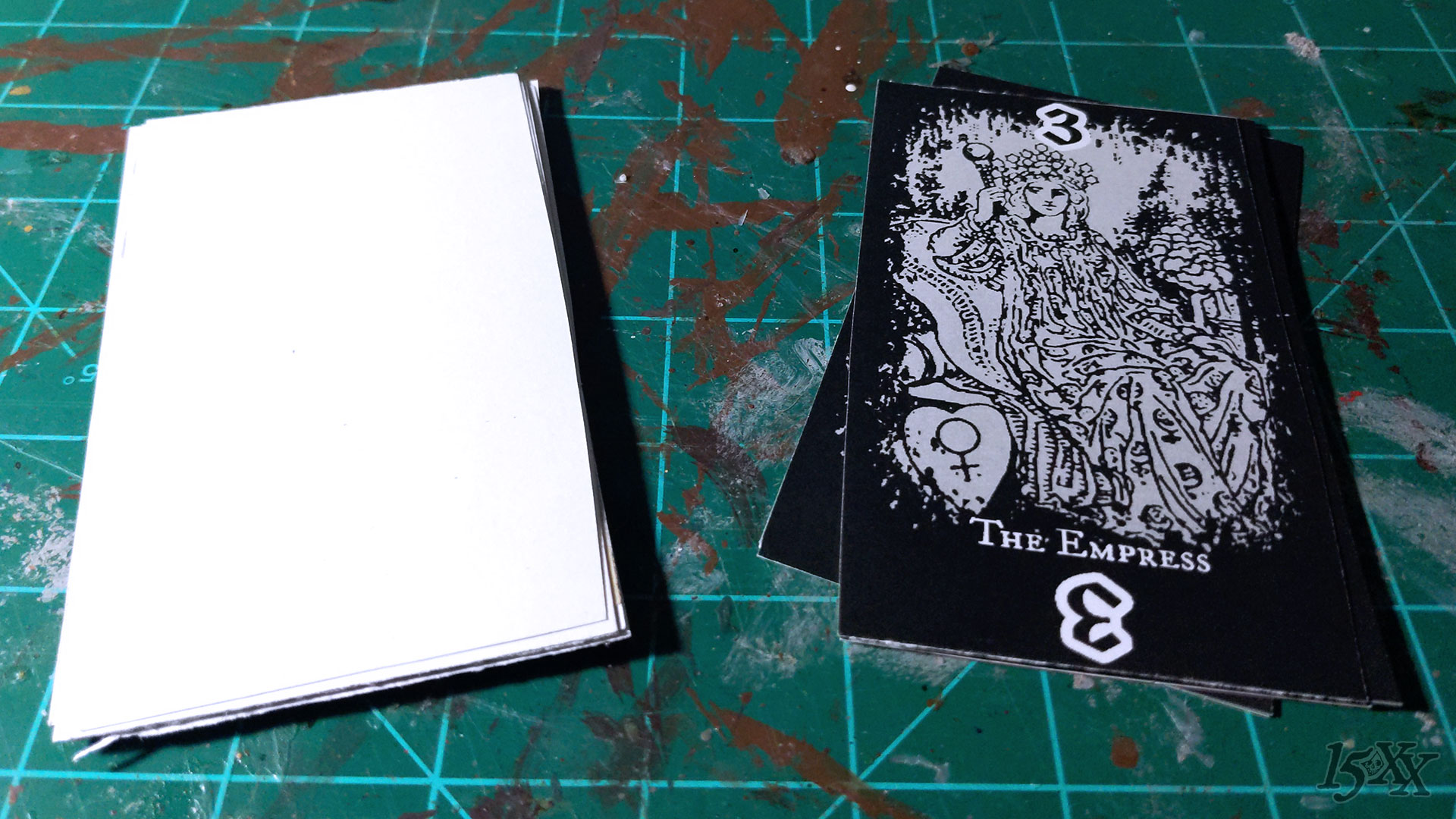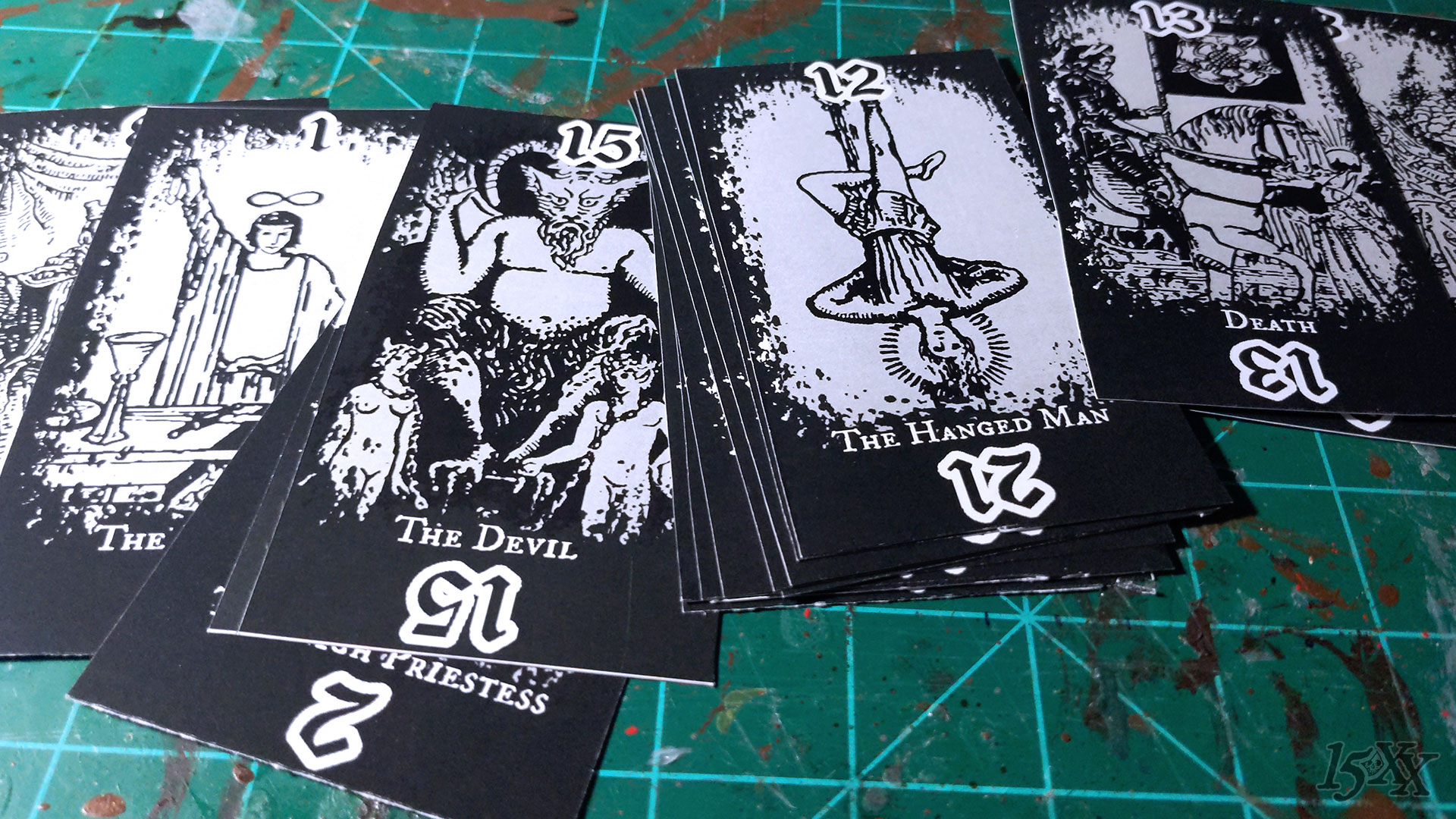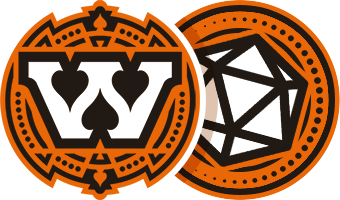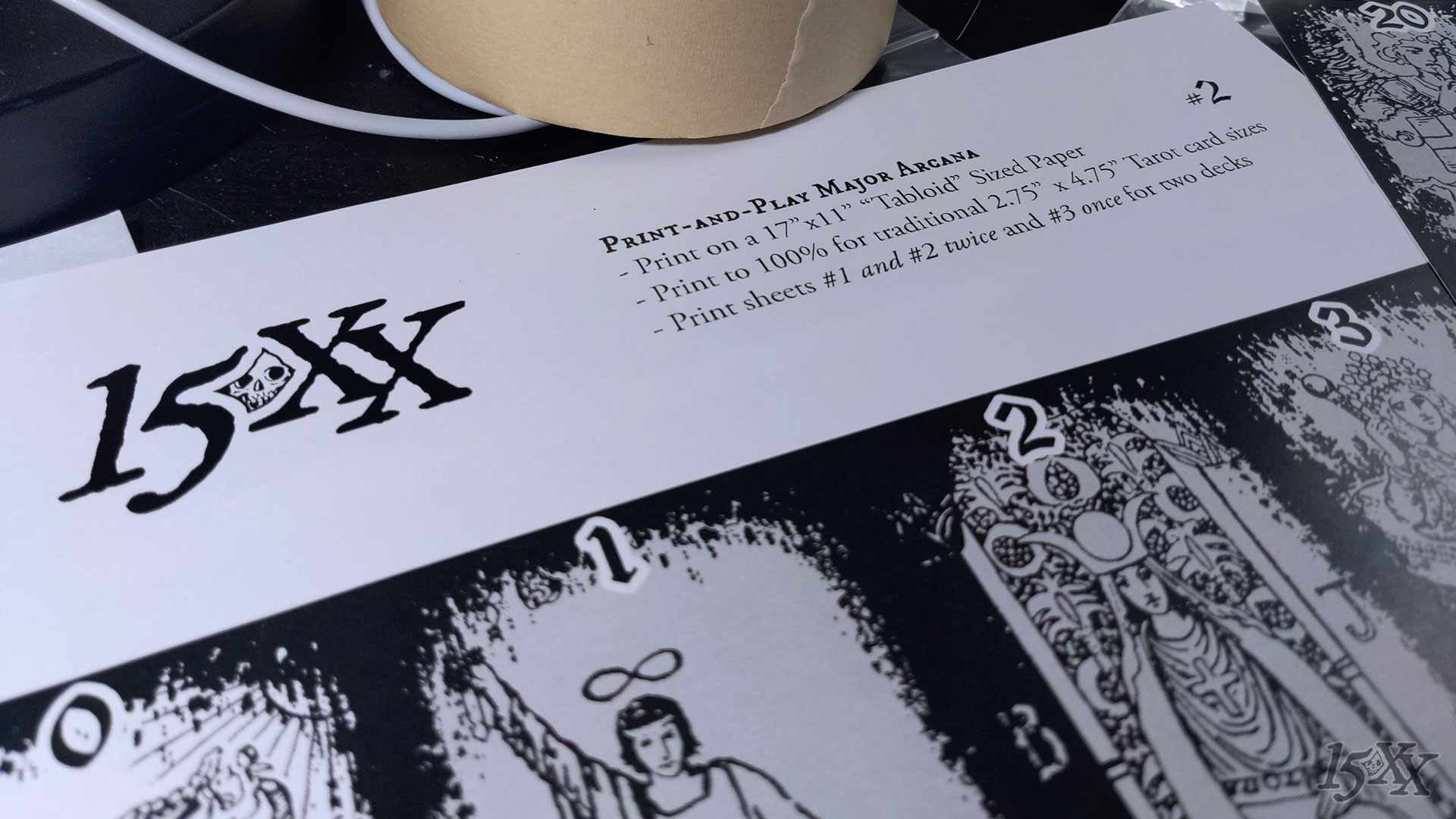Update: In working through this concept – and feedback – I’ve decided to stay with the d10 dice pool mechanics that have already proved to work in playtesting. I think the idea of the Major Arcana as a randomizer is still an interesting one, but they simply are too much of a conceptual stumbling block out of the game for most players. Their inclusion would become a distraction, rather than something that adds to the game’s atmosphere.
In thinking through and around the question of critical fails (specifically to model the advantages and risks firearms have compared to bows and crossbows), I’ve started to consider a new approach to the games two core mechanics of the dice pool and initiative tokens.
Take a look at this and tear it apart. I’m sure there are plenty of edge cases and what-abouts I haven’t considered yet.
d10 Dice Pools and Initiative Tokens: The Current System
The Dice:
- Players roll a pool of 1-4 d10’s based on a warband-level stat (“Quality”).
- Roll at least one die equal to or under a unit-level stat for success (“Skill”).
- Bonuses/buffs increase the dice pool by one (to a max of 4d).
The Initiative Tokens:
- Players also use a pool of Tokens to bid on initiative (choosing to go first or second)
- Players also use Tokens to pay to react during their opponent’s turn and invoke warband-specific buffs (Motivation, Trouble, Social Class).
- Lastly, Players use those Tokens to maneuver around the battlefield at the beginning of the game during the “Fog of War” phase – here they represent their warband moving unseen, as of yet, by their enemy.
This all works fine. I like how I’ve been able to build the rules around a very simple bonus mechanic and there’s no math in the die rolling: roll a dice pool and check the lowest result. It’s fast, it differentiates different warbands, and it the four Party Qualities (zeal, discipline, supply, and experience) add a strong narrative element.
It’s just… ho hum.
Dice mechanics and tokens don’t need to have pizzazz.
Being fancy just for the sake of being fancy ends up being bad… a lot.
But can I build on this basic foundation with something a little more… evocative?
The Idea: Tarot Major Arcana as Randomizer and Resource

A number of miniatures games successfully use cards as randomizers (just to name four: Malifaux, To the Strongest! and its ECW sibling For King & Parliament!, and Anno Domini 1666). But what if there’s another option beyond the 52 card, four suit traditional poker deck?
What about using the 22 Major Arcana cards of the Tarot deck?
As an armchair historian and professional designers there’s something compelling about this set of named, numbered, and illustrated cards.
In the 1500s and 1600s the 15XX rules are set in, the Major Arcana were part of decks used in popular card games of the time, albeit with illustrations that carried allegorical reflections of court and society. They didn’t take on their esoteric, fortune-telling reputation until well into the modern era.
Using them as both a randomizer and resource mechanic adds a visually and thematically evocative aspect to the game in ways that rolling dice simply don’t. But they aren’t without their potential downsides and design challenges to solve!
Proposed Major Arcana Mechanics
You will see that this change keeps in place the core concept: “dice” pool, “roll” low, and bidding for advantage.
As part of warband creation options:
- A Player chooses a Major Arcana card for each Group (building block of the warband), and all Groups must have different cards. Players are encouraged to add narrative or roleplaying fluff to these choices, but each card also comes with a buff or special action.
Major Arcana as dice replacements:
- Players can draw a 1-4 cards up to their relevant warband-level state (Quality), until they get a success.
- Drawing a card equal to or under the unit-level stat (Skill) is a success.
- Bonuses/buffs increase the number of cards a Player may draw by one (to a max of four cards).
- If a Player draws the Major Arcana for a Group during its action, the special rule or benefit happens at this time. These benefits are TBD. But, they won’t effect accuracy or damage (so choosing an card is largely a strategic choice: low cards give you benefits when you would have already succeeded, while high cards give you a benefit when you likely would have failed).
- Cards drawn for normal actions are discarded into an “Action Pile.” If a player has no more cards to draw before the end of the round, they reshuffle their Action Pile.
As replacements for the initiative tokens:
- Player’s bid against each other for initiative from their deck. They may bid as much as they wish. Cards are bid facedown and discarded in a separate “Initiative Pile.” Cards in the Initiative Pile are not reshuffled until the start of the new Round (along with cards in the Action Pile).
- Likewise, Players can bid to React to their opponent’s actions. This costs at least one card. Their opponent does not have to counter-bid, but may if they want. Cards bid as a part of a reaction also go in the Initiative Pile.
- Players may pay a single card to invoke a success or failure based on their Group’s Motivation, the Social Class of a Group, or their opponent’s Troubles. This benefit can only be used once a game per category, and the card goes to the Initiative Pile.
- During the “Fog of War” phase, Players place their Groups’ Major Arcana around the table, face-up. Your opponent will see what cards you have, but not what Groups they represent.
A Comparison Table

Potential Challenges
Full Tarot decks are 78 cards. Does this force potential players to buy something they may not use – or risk losing the 56 other cards?
I’ll offer a print-and-play set of Major Arcana as downloadable PDFs (during playtesting) and once the game goes live, a Print-on-Demand card deck.
This is no different than games and rules requiring specific counters or play pieces.
Using cards as a limited resource for bidding penalizes Players with higher Quality scores who can draw more cards.
There may need to be two discard piles. One for those cards gambled with and discarded, and another for cards drawn normally.
The drawn discard pile can be reshuffled when the player runs out of cards. This allows players who can draw more cards to do so.
In some Tarot decks, the positions of Strength and Justice are swapped between 8 and 11.
This doesn’t end up being a problem, as any specific rule or effect will be based upon the card name, rather than its numerical value. So, two players should be able to use Tarot cards of either of those types without an issue.
How does gameplay or player experience change with cards versus dice? As more cards are drawn and discarded, the potential outcomes become smaller.
Truthfully, I have no idea yet. I’d have to run some games and get feedback from playtesters.
Combine dice and tokens into one thing. Still doesn’t automatically resolve the critical fail question, but… I’m curious.
Hope is that it isn’t gimmicky for the sake of being gimmicky, but solves problems while being evocative, as well. Long term goal – perhaps for any future publishing or Kickstarter – would be a custom illustrated set, but that’s in the future.
Problems: have to acquire decks, not all decks are the same (Strength Justice switch), I’ll provide print-and-play, weird reactions to the Tarot, maybe, but I think it’s evocative; making high number cards meaningful
What’s the impact of the reducing pool of options? It’s not like this is a plain-ole d20(d22).
Print-and-Play Card Links

Realizing not everyone is going to have one, much less two, Tarot decks sitting around, I’ve created a set of print-and-play sheets of the 22 Major Arcana.
They have been designed to be printed at 100% on American “Tabloid” sized paper (17″x11″).
A few questions:
- More cards fit on 17″x11″, but for most of us, that means going to a copy shop (still in the era of Covid). Should I instead offer more pages on normal sized 8.5″x11″?
- Does this read okay? I swapped out the traditional Roman numerals for Arabics (and added an inverted number at the bottom) for readability.
I’d appreciate your thoughts – both on the potential mechanics change as well as the print-and-play sheets.


Sounds awesome! Maybe you could do away with the action discard pile and just reshuffle drawn cards into the deck, so all the options are there for the next draw?